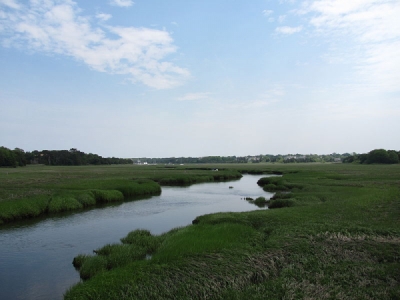
Posted on July 16, 2019
Healthy salt marshes provide a number of important ecological functions that are essential to the preservation of the quality of the Cape Cod environment. Salt marshes serve as nurseries and habitat for many commercial fish species, shellfish, birds and mammals. A healthy marsh also serves as an important carbon sink similar to rain forests, helping store carbon that would otherwise contribute to climate change. Marshes protect public and private infrastructure and create a coastal buffer to flooding and storm surge. A study by the Nature Conservancy following Hurricane Sandy found that coastal wetlands prevented $625 million in property damages from flooding.
Close to 36 percent of Cape Cod’s salt marshes have been lost or severely degraded. The main cause has been human development and restriction of tidal flow from the construction of roads, railways and tide gates across streams that feed into the marshes. Restoration of tidal flow by removing these restrictions can return these systems to their more natural state and regain the extensive and economically valuable benefits these resources provide.
The Association to Preserve Cape Cod has been involved in a dozen salt marsh restoration projects across the Cape over the past two decades and supports several others currently underway, including Parkers River in Yarmouth and Mayo Creek and Herring River in Wellfleet. While each is unique, the process for restoration and the resulting improvements are predictable. Increased tidal flow restores salinity in the water, supporting improved soil chemistry, the return of native vegetation, and enables aquatic species like river herring and brook trout to swim upstream to spawn in freshwater.
The recent “My View” opinion piece, “Sesuit Creek project bodes ill for Herring River” (July 2) by Ronald A. Gabel, makes broad-brush statements and conclusions based on supposition that are counter to existing facts and reports. While the Sesuit Creek tidal restoration is taking time, decades of alteration and degradation are not reversed in the blink of an eye. By multiple measures, this restoration has been a success. Nature takes time to heal. Restoration projects are not like rolling out sod on a damaged lawn.
Mr. Gabel’s conclusion that the Sesuit restoration has “failed” is not supported by the evidence, which objectively demonstrates that the restoration has succeeded in restoring tidal flow, reducing invasive vegetation and reopening flow for herring to upstream-spawning habitat. While bare mudflats exist in the area immediately upstream of the bridge, areas farther upstream previously dominated by freshwater and invasive plants are now filled with Spartina alterniflora, a native salt marsh plant. These bare areas in the restored marsh are not dead but simply unvegetated. The marsh still supports a diversity of wildlife from fiddler crabs to osprey.
The salt marsh pilot planting project begun in 2018 that Mr. Gabel falsely claims was done “without much success” has a documented year-one 98 percent survival of plants and an increase in plant growth. The planting was not intended to fill in the bare areas immediately but to improve recovery and restoration outcomes over time.
The claim that the Sesuit restoration is the cause of sedimentation in the inner harbor is fiction. The town of Dennis Waterways Asset Plan concludes “the restoration project at the Bridge Street crossing of Sesuit Creek did not substantially increase sedimentation patterns within the inner harbor.” The Sesuit Harbor Use Study states that “the likely driver of draft issues in the inner harbor is the absence of maintenance dredging for over 50 years.”
Other contributing factors inconsistent with the anti-restoration rhetoric are ignored to help strengthen an otherwise misguided and scientifically unsupported position about this project and to cast doubt on other much-needed restoration projects.
To point to the Sesuit Creek salt marsh restoration and planting as a failure is false, and to suggest this means the Herring River project, with its extensive monitoring and planning for slow and progressive management, will cause harm is unfounded based both on the science of these two projects and the large number of successful tidal restorations completed across the region. Allowing the misleading statements of a few critics to prevent other degraded systems from being restored would be a disservice to the entire region.
Andrew Gottlieb is executive director of the Association to Preserve Cape Cod.
Source: capecodtimes.com





